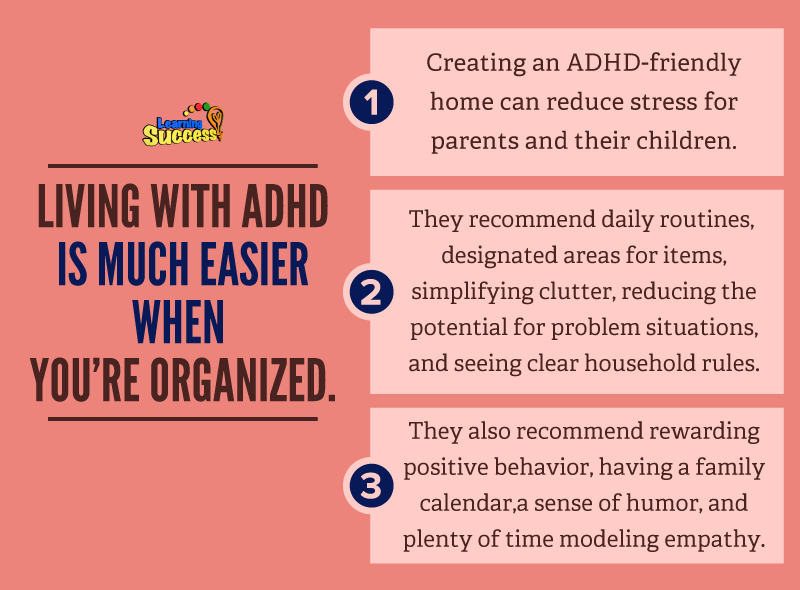
You don’t need to be an expert in feng shui to make your home a more relaxing and productive space for your child with ADHD. Experts suggest that creating an orderly space with clear expectations of where things go will greatly reduce the stress involved with lost and misplaced belongings. Eliminating clutter and tempting furniture (for example, swivel chairs) can help your child avoid becoming distracted. And as an added bonus, your home will look neater as well!
Living with children is chaos so be organized.
The article ADHD Friendly Ways to Organize a Home recommends such strategies as:
- Setting up and maintaining daily routines.
- Providing consistency and predictability.
- Having designated areas for household items, (prevents frustration associated with losing things)
- Reducing clutter to cut down on distractions
- Structuring your home in such a way that it is safe (and not a problem) for active children to run, dance, or jump around.
Also recommended is:
- Making very clear house rules. Both parent and child know and understand the consequences of misbehaving
- Rewarding positive behavior more than punishing bad actions
- Grouping all members’ schedules into one central calendar
- Keeping a sense of humor
- Trying as often as possible to model desired behaviors, like empathy and kindness ( children imitate what they see)

Living with ADHD is easier when organized.
An ADHD-friendly home is set up to make it easy for members with ADHD to manage daily stress and avoid emotional meltdowns. By following these basic rules, you’ll not only simplify your family’s life, but you’ll lower stress levels for everyone. Routines make life more predictable. From morning routines to afterschool routines to dinner routines to bedtime routines, schedules help provide consistency. Try to keep the time that your child wakes up in the morning, eats, and goes to bed each night fairly consistent from day to day. This is helpful advice for adults, too.
There should be a place for everything, so that everything can be kept in and found in its place. For example, each child should have a designated area for bag pack, shoes, coats, or toys. If the child plays sports, provide a designated area for equipment. If she is involved in ballet, her ballet bag has a designated home. The clean leotard, tights and ballet slippers all stay in the ballet bag.
For parents there are designated areas for keys, purse or wallet, glasses. When everything has its own place and the family consciously makes this effort to get items in their designated spots, items can be found when needed. This also helps eliminate the rush-out-the-door-anxiety or frustrations people experience when they cannot find needed things.
Key Takeaways:
Start small. When it comes to organizing, one of the mistakes people with ADHD make is to try to work on everything at once
In the article, 12 Tips for Getting Organized for Adults with ADHD, author Margarita Tartakovsky, M.S. makes the following points.
Structure the home in order to avoid problem situations. For example, if your child is extremely active and prone to flinging his or her arms and body around, donât fill the family room with breakables and valuable antiques. Make the home kid friendly. Do not have swivel chairs in the house. Do not get your child an ATV (all terrain vehicle) or BB guns. These items can set your ADHD child up for trouble. So think ahead and make simple adjustments to help prevent problems from occurring in the first place.
Living with children can be chaos, but living with children who have ADHD can be a train wreck. Especially if your not organized. The solution to this is creating a organized ADHD friendly hom. Reducing the amount of clutter one has in their home. Allowing ample time to complete projects. Use rewarding behavior.
If you or someone you know is having difficulty with ADD or ADHD, and that affects learning, then you’ll want to try our free assessment. Learn how to get to the root of the problem. Find out which micro-skills need strengthening and increase learning ability. Take our assessment by clicking here.
Do You Need help with a Learning Difficulty?
Our simple online analysis will help you get to the core of the problem and find the right solution for you.
Understanding how to help someone with a learning difficulty starts with understanding which micro-skills are affected. When you learn which of the micro-skills is the problem, you will then be on your way to solving it.
You'll also learn how to:
- Build confidence
- Enhance Learning ability
- Eliminate avoidance
- Build grit
You can get this analysis for free by filling out this simple form. This will help you get to the bottom of a learning difficulty and provide you with a solution. If you are ready to put this problem behind you click the button below and fill out the form.










